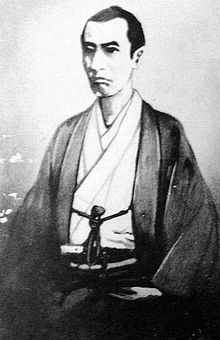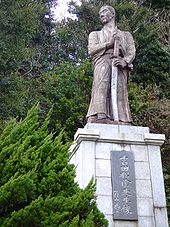Yoshida Shōin
Yoshida Shōin ( Japanese 吉田 松陰 ; real name: 吉田 矩 方 Yoshida Norikata , first name: 吉田 寅 次郎 Yoshida Torajirō ; born September 20, 1830 in Matsumoto (now Hagi ), Japan ; † November 21, 1859 in Edo ) was a Japanese intellectual, Teacher and revolutionary. He was one of the leaders and co-founders of the Sonnō-jōi movement and thus a forerunner of the Meiji Restoration . He was executed in 1859 for assuming responsibility for the assassination attempt on the leading politician of the shogunate , Tairō Ii Naosuke .
Youth and education
Yoshida Shōin was born as the second son of the low-ranking samurai Sugi Yurinosuke in the village of Matsumoto, which was near Hagi , the capital of Han Chōshū . He had a fragile-looking constitution, but due to his great intelligence an incredibly strong will and just as much self-control. At the age of five he began studying military tactics and reading the Chinese classics . At the age of eight he read the works of the Chinese philosopher Mengzi and began attending school in Chōshū. The following year he gave his first lessons at this school. In 1840, at the age of 10, he won a daimyo award for excellent reciting of military classics and was able to go to the Meirinkan , the Han school for the descendants of the daimyo of Chōshū and their subordinate samurai. This was possible despite the low rank of his father, because in the course of the particularly extensive reforms taking place in the Daimyat Chōshū , which are named after the Tempō era , these schools were also opened to other circles of the samurai social class in order to strengthen their morale. The samurai Murata Seifū was primarily responsible for carrying out these reforms .
At the age of fifteen, Yoshida Shōin was startled by things that were going on outside of Japan. Since the beginning of the 19th century there had been increasing attempts by European countries to establish contact with Japan. For example, already was in 1846 the American Commodore James Biddle in the Bay of Edo landed and had requested the opening of the country to trade. However, he was turned away and left without having achieved anything. The threats that the rejected crews made when they said goodbye caused the Japanese to fear the foreigners. The Japanese were also well aware of China's defeat in the First Opium War of 1842. The Japanese were able to obtain some knowledge about the Europeans from Chinese sources, who for their part were only very incompletely informed about Japan from Dutch sources. These influences triggered a xenophobia that was even legally supported on the part of Bakufu through the edict to expel foreign ships and which had not existed until the beginning of the 19th century.
In 1848, based on his knowledge of the Europeans, Yoshida Shōin gave the Daimyō Chōshūs the advice to prepare for an invasion. In 1851 he accompanied the daimyo on a trip to Edo , where he was tutored by Sakuma Shozan , the most recognized expert in Western military history in Japan.
Forced opening of Japan
Yoshida was in Edo when Commodore Matthew Perry appeared with his fleet in June 1853 outside the capital of Japan and demanded the end of the isolation of Japan . Perry's ships were much more heavily armed based on James Biddle's report. Therefore, this time he was able to get Japan to enter into trade relations with the United States. He saw how the shogunate in March 1854 the Treaty of Kanagawa with Perry graduated, which was even felt by the Japanese public and the Bakufu as humiliating as it was in stark contrast to the previously driven policy of the 1825 edict passed for the expulsion of foreign vessels. Particularly annoying for the Japanese was that the Bakufu under Abe Masahiro did not offer the slightest resistance to the demands of the Commodore, which was the core message of the law of 1825. As a result, the Bakufu lost its credibility in the eyes of Japanese such as Yoshida Shōin, who took the edict to expel foreign ships very seriously. Yoshida and his teacher Sakuma Shozan therefore planned drastic countermeasures on their own against the dishonor they felt for Japan. Initially, he planned to get to know the enemy and travel to the United States with Perry. He wrote a letter to Perry asking to be taken on one of his ships. However, the letter was forwarded by Perry to the officials of the shogunate. Yoshida was immediately arrested and returned to Hagi as a prisoner.
Shōkasonjuku
Yoshida Shōin was placed under house arrest after being held in Noyamagoku Prison in Hagi for over a year. The resulting time he used to found his private school Shōkasonjuku . This school was attended by about 80 young nobles from the lower samurai class. Yoshida Shōin taught his students the philosophy of the Chinese classics. In addition, he took every opportunity offered the opinion that the Tennō was the actual head of state of Japan. But he was also of the opinion that the country should open up to adopt the technologies of the foreigners and build a strong military apparatus. He advocated the idea of uniting the political power of the imperial court in Kyoto and the shogunate in Edo in order to avert the threat of foreign rule in Japan. Once this goal was achieved, Japan had to expand territorially into an East Asian empire: the Kuril Islands , Sakhalin , Kamchatka , Formosa (today Taiwan ), Korea, Manchuria and large parts of Eastern Siberia should be annexed according to Yoshida Shōin's ideas. With these visionary ideas that he spread, he helped determine Japan's future path in history. His students included many young samurai who would later belong to the core of the country's Meiji oligarchy . Among them were the two future Prime Ministers Itō Hirobumi and Aritomo Yamagata .
Sonnō-jōi movement
According to Japanese law of the Edo period, the shogun had to receive permission from the Tennō when he entered into a contract with a foreign power. In June 1858 , Ii Naosuke , the regent ( Tairō ) of the Shogunate, signed a trade agreement with the United States, the Harris Treaty , although the ruling Tennō Kōmei refused this permission. Yoshida Shōin, like many other proponents of a restoration of imperial power, was enraged by the actions of Ii Naosuke, which they perceived as a disregard for imperial authority. He became a radical leader of the Sonnō-jōi movement , which had set itself the goal of eliminating the shogunate, restoring the power of the Tennō and chasing the "foreign barbarians" out of the country. He therefore took part in a conspiracy to assassinate the regent. But first Hotta Masayoshi should be killed, the Chancellor ( Rōjū ) whom Ii Naosuke had unsuccessfully sent to Kyoto in order to obtain the necessary permission from the Tennō. In November 1858 the preparations for the implementation of the plan were made. It did not come to fruition, however, because daimyo Mōri Takachika of Chōshū (rightly) feared that the act would result in a punitive expedition by Bakufu. Yoshida Shōin was imprisoned again in Hagi in December 1858. He is one of the victims of the Ansei persecution , which Ii Naosuke initiated to fight the opposition to Bakufu. In May 1859 Yoshida Shōin had to be extradited to Edo on the instructions of Bakufu and was interrogated by officials of the shogunate since June. He did not deny his views on the future form of government in Japan and took the responsibility for the assassination attempt on Ii Naosuke all by himself. The consequence of this was that he was sentenced to death on October 17, 1859 . The execution took place on November 21, 1859 and was carried out in the traditional way with the sword.
Aftermath
Yoshida Shōin himself was no longer allowed to experience the fruits of his labor and the transformation of Japan into a modern state, but his students became important figures in the Meiji Restoration . In his hometown of Hagi, the Shōin shrine is dedicated to him (built in 1907, which also houses the Shokasonjuku). Another Shōin shrine was built for him in 1882 in Wakabayashi in Setagaya- ku. His grave is also located there.
literature
- Albert M. Craig: Chōshū in the Meiji restoration ; Lexington Books, 2000; ISBN 0-7391-0193-5
- Heinrich Dumoulin : Yoshida Shôin (1830-1859). A contribution to understanding the spiritual sources of Meiji renewal ; Monumenta Nipponica , 1938, No. 2
- N. Taylor Gregg and Sam Abell (photographs): Hagi: Where Japan's Revolution Began , National Geographic , Vol. 165, No. June 6, 1984 pages 750-773 [1]
- Marius B. Jansen: The Making of Modern Japan ; B&T; ISBN 0-674-00991-6
- Hirakawa Sukehiro, Marius B. Jansen (Ed.), John Whitney Hall (Ed.), Madoka Kanai (Ed.), Denis Twitchett (Ed.): The Cambridge History of Japan - Volume 5 - The Nineteenth Century , Chapter 7: Japans turn to the West , Cambridge University Press 1989, ISBN 0-521-22356-3
Web links
- De-min Tao: Yoshida Shôin's Petition Found at Yale Archives ; Kansai University Japan (PDF file; 165 kB)
- Exhibition of the Japanese parliamentary library with portraits and short biographies of important Japanese personalities of the modern age (English, Japanese)
- A biographical article about Yoshida Shoin by Romulus Hillsborough ( Memento of February 7, 2009 in the Internet Archive )
- Chapter "Yoshida Torajiro" in The Travels and Essays of Robert Louis Stevenson (pp. 150-165) .
Individual evidence
- ↑ Yoshida Shôin's Petition Found at Yale Archives (PDF; 169 kB)
- ^ Walter McLaren: A Political History of Japan During the Meiji Period ; George Allen and Unwin London 1916, pp. 227-236
| personal data | |
|---|---|
| SURNAME | Yoshida, Shōin |
| ALTERNATIVE NAMES | 吉田 松陰 (Japanese); 吉田 矩 方 (Japanese, real name); Yoshida Noritaka (real name); 吉田 寅 次郎 (Japanese, nickname); Yoshida Torajirō (first name) |
| BRIEF DESCRIPTION | Japanese intellectual and revolutionary |
| DATE OF BIRTH | September 20, 1830 |
| PLACE OF BIRTH | Matsumoto , Japan |
| DATE OF DEATH | November 21, 1859 |
| Place of death | Edo |



